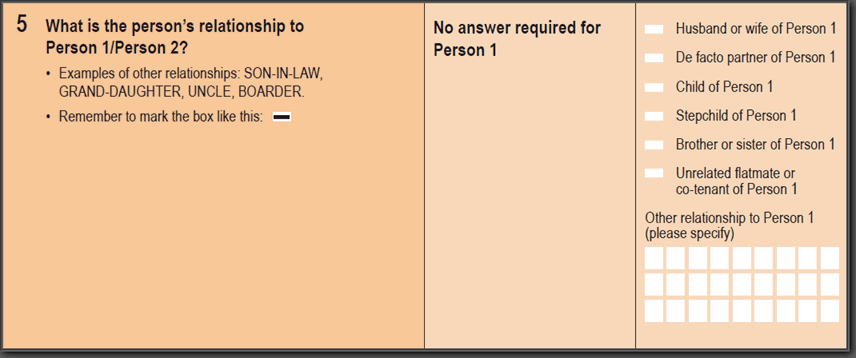Family Number (FNOF)
This variable categorises each family as either the primary, second or third family within the household. Families in a one family household are always classified as the primary family.
This variable is applicable to all families in family households.
How this variable is created
Family number is based on the relationships people have with other within the same house. It is mainly derived from the Relationship in Household question on the Census Household Form. An image of this question is provided below. Persons reported as temporarily absent are also considered when this variable is derived.
Where there is more than one family in a household on Census night, the family with dependent children is designated as the primary family or in multi-generational households, the younger family. If there was more than one family, and no children were present in the household, then the first family identified on the census form becomes the primary family.
Variable history
This variable was first introduced in 1971, to replace the previously used Family Group (FMGF). The mnemonic used has changed several times.
No changes were made to this variable in 2016.
Non-response rate
Non-response rate only applies to data items that directly reflect responses to individual Census form questions. Non-response does not apply to family variables, including Family Number. Families are derived for occupied private dwellings where a family composition can be determined from the relationship within the household (RLHP) responses. For more information, refer to Understanding Census data quality.
Data usage notes
In a multiple family household, a maximum of three families can be identified within a single dwelling. This is in accordance with current ABS standards. In cases where more than three families are identified in a household, the first three families are coded and the other persons are classified as either related family members of the primary family or non-family members. While this may have only a small effect on total family numbers overall, the impact may be more significant among population groups whom live in multi-generational households or with large numbers of extended family members.
The term 'Primary family' is an ABS term that is used to aid coding of household relationships. This should not be misinterpreted as signifying that this is the main family in the household or the family that owns the house or for another reason, other than for ABS relationship coding purposes.
Further information
The variable content for Family Number is available in the 2016 Census Dictionary.
For more information on family number, see the Census Dictionary glossary entry.
For information on the Relationship in Household question and data item, see the data quality statement for Relationship in Household.
For information on family type and family composition, see the data quality statement for Family Composition.
Household form question image
Question 5 as it appears on the 2016 Census Household Paper Form:

A text only version of the online Census Household form is available from the Downloads tab.
 Print Page
Print Page
 Print All
Print All